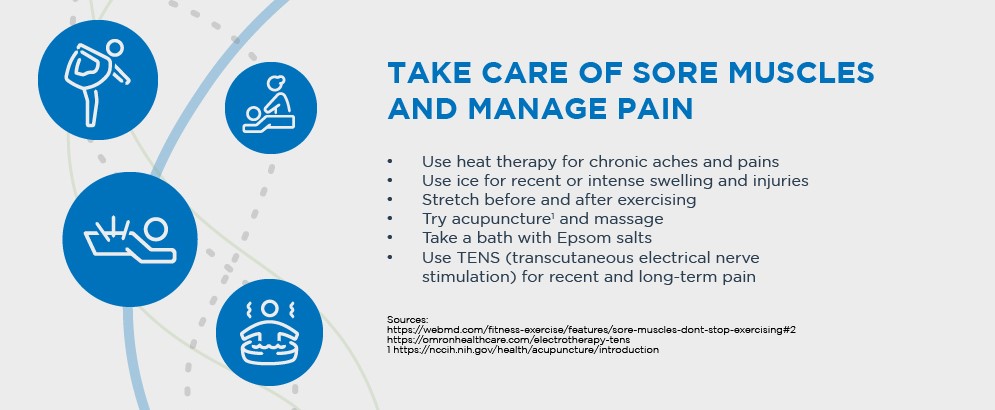Chronic and acute pain have become some of the more common reasons people look for medical care. Back pain in particular will affect almost everyone at some point in their lives. When prescribed and monitored, medication can be very helpful for dealing with pain. Misuse of opioids and even over-the-counter medications make it clear that pain-relief alternatives are desperately needed.
Counseling, mindfulness coaching, exercise, electrotherapy, and hot/cold treatments are some examples of drug-free alternatives that can be beneficial for managing pain, with little to no risk.
Coaching, counseling and behavioral approaches
Pain can influence our quality of life and the way we think about pain. Health and wellness coaching is a growing practice of positive motivational counseling, ultimately leading to a change in mindset about pain. This specific type of coaching has been proven to be effective in managing pain from fibromyalgia and chronic pain in general.
Psychosocial Intervention is another form of counseling that employs a certified professional to target and repair the deep-seated psychological effects of pain.
Pain tolerance can also be affected by social activities. Research suggests that positive social interactions and strong friendships can actually lead to decreased pain sensitivity.
Relaxation and concentration techniques
In Pain Relief: Natural and alternative remedies without drugs or surgery, Harvard University outlines various mental exercises as practical methods for pain management.
Mindfulness, a form of meditation
According to Harvard University, being mindful of the present moment, whether sitting in meditation or throughout the day, is commonly and increasingly recommended in pain clinics.
Progressive muscle relaxation
Focusing on relaxing each set of muscles at a time can help lessen the experience of pain.
Breathing techniques
Relaxing the stomach and shoulders and breathing through the diaphragm can draw oxygen deeper into the lungs and bring about a calming state that lessens the experience of pain. This type of breathing exercise is also a great form of meditation to inhibit stress.
Hypnotherapy for pain
Hypnosis has been used for more than 150 years to help manage pain. Hypnotherapists often teach their patients visualization techniques to help achieve goals, which can include pain reduction.
Exercise as a form of pain management
Exercise therapy can be an effective way to relieve musculoskeletal pain. According to Harvard University, limiting your movements can weaken muscles, which puts more pressure on joints and can affect posture. It suggests that muscle weakness and poor posture can progress into further problems. Joint pain relief workouts can even help postpone or avoid surgery by building up supportive muscles and improving flexibility.
Tai Chi and Yoga
For centuries, Tai Chi and Yoga have been believed to improve flexibility, circulation, strength, balance and overall physical and mental well-being.
Tai Chi, a low-impact, mellow form of martial arts, has shown positive evidence of improving osteoarthritic pain, low back pain and osteoporosis.
Yoga, a form of exercise combining physical postures, breathing techniques, and meditation, has likewise been shown to improve pain from arthritis, fibromyalgia, migraines and low back pain.
Electrotherapy
Transcutaneous Electrical Nerve Stimulation, or TENS, is an effective method of relieving pain without medication. TENS uses pain-free electrical currents delivered through soft pads to affected areas to disrupt or distract pain signals.
Studies show TENS is a safe and patient-friendly pain intervention that provides powerful relief when applied at a stronger intensity.
People who experience work-related pain from repetitive motion and stressful activities are great candidates for TENS therapy. TENS can also be effective for recovery from physical workouts.
Tips for using a TENS unit at home:
- To get the right effect, follow the instructions on your TENS unit carefully
- Start with a 15-minute session
- Rate your pain from 1 to 10 before, during and after your session
- Start soon after you receive the injury or notice pain

Other pain management therapies
The National Center for Complementary and Integrative Health provides information about complementary therapies that may be helpful in managing pain, including:
- Acupuncture
- Biofeedback
- Chiropractic care
- Cold and heat therapy
- Herbal or nutritional pain relievers
- Massage
- Music therapy
- Physical therapy and occupational therapy
- Topical pain relievers (e.g., herbal pain patches)
- Various pain-relieving devices (similar to TENS)
Prevent joint and muscle pain by knowing the causes
Tension, stress, overuse and minor injuries are the most common types of muscle pain. Common causes of joint pain are:
- Osteoarthritis
- Past unhealed injuries
- Repetitive/forceful movements from exercise or work
- Posture
- Aging
- Inactivity
Staying aware of these causes, especially preventable ones like posture, inactivity or overuse, are even more important than subsequently treating pain.
Concluding thoughts on pain and medication
Chronic and acute pain affects as many as 70 million Americans, and as opioid misuse continues to rise, drug-free alternatives are becoming more commonplace in the medical community. There are many ways to treat pain, so make sure to talk with your healthcare provider to find the therapy that works best for you.